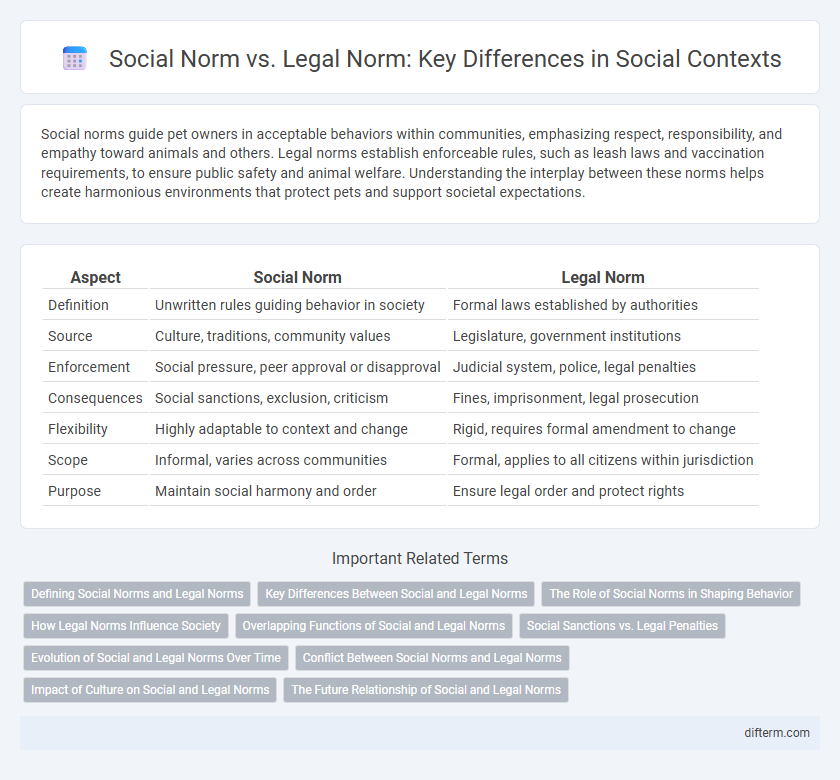Social norms guide pet owners in acceptable behaviors within communities, emphasizing respect, responsibility, and empathy toward animals and others. Legal norms establish enforceable rules, such as leash laws and vaccination requirements, to ensure public safety and animal welfare. Understanding the interplay between these norms helps create harmonious environments that protect pets and support societal expectations.
Table of Comparison
| Aspect | Social Norm | Legal Norm |
|---|---|---|
| Definition | Unwritten rules guiding behavior in society | Formal laws established by authorities |
| Source | Culture, traditions, community values | Legislature, government institutions |
| Enforcement | Social pressure, peer approval or disapproval | Judicial system, police, legal penalties |
| Consequences | Social sanctions, exclusion, criticism | Fines, imprisonment, legal prosecution |
| Flexibility | Highly adaptable to context and change | Rigid, requires formal amendment to change |
| Scope | Informal, varies across communities | Formal, applies to all citizens within jurisdiction |
| Purpose | Maintain social harmony and order | Ensure legal order and protect rights |
Defining Social Norms and Legal Norms
Social norms are unwritten rules that govern behavior in society based on shared values, customs, and traditions, guiding individuals on what is considered acceptable or unacceptable within a community. Legal norms consist of formal rules and regulations enacted by governmental authorities, backed by official sanctions and enforcement mechanisms to ensure compliance. While social norms rely on collective social approval or disapproval, legal norms depend on codified laws and judicial systems to regulate conduct.
Key Differences Between Social and Legal Norms
Social norms are unwritten rules that govern behavior within a community, shaping customs and traditions through collective acceptance and informal sanctions. Legal norms consist of formally codified laws enforced by governmental authorities with clear consequences such as fines or imprisonment for violations. Key differences include their origin--social norms arise organically from societal consensus, while legal norms are created by legislative bodies--and their enforcement mechanisms, with social norms relying on social pressure and legal norms on judicial systems.
The Role of Social Norms in Shaping Behavior
Social norms serve as unwritten rules that guide individual behavior within communities, often exerting influence stronger than legal norms by fostering conformity through shared values and expectations. These norms regulate everyday interactions by promoting cooperation and discouraging harmful actions without formal enforcement mechanisms. Understanding the role of social norms is crucial for policymakers aiming to design effective interventions that complement legal frameworks and encourage ethical conduct.
How Legal Norms Influence Society
Legal norms establish clear rules and enforceable standards that regulate behavior within society, providing stability and predictability in social interactions. These norms influence social norms by formalizing expectations and consequences, thereby shaping collective behavior and moral values over time. Compliance with legal norms promotes social order and reinforces the legitimacy of institutional authority.
Overlapping Functions of Social and Legal Norms
Social norms and legal norms both regulate behavior by establishing expectations within a community, often overlapping in promoting order and cooperation. While social norms rely on informal sanctions like social approval or ostracism, legal norms enforce compliance through formal penalties such as fines or imprisonment. This intersection ensures that critical societal values are upheld through both community-driven customs and institutionalized laws.
Social Sanctions vs. Legal Penalties
Social sanctions, including shaming, ostracism, and informal reprimands, serve to enforce social norms by encouraging conformity within communities. Legal penalties, such as fines, imprisonment, and other judicial punishments, are formal mechanisms imposed by the state to uphold legal norms and deter criminal behavior. While social sanctions rely on collective community pressure, legal penalties depend on established laws and formal judicial processes.
Evolution of Social and Legal Norms Over Time
Social norms evolve gradually as collective behaviors and cultural values shift, reflecting changing societal attitudes and informal expectations. Legal norms adapt through formal legislative processes, often codifying social changes after widespread acceptance or responding to emerging issues. The dynamic interplay between social and legal norms illustrates how laws both influence and are shaped by evolving social practices and moral standards.
Conflict Between Social Norms and Legal Norms
Conflict between social norms and legal norms arises when societal values clash with established laws, leading to non-compliance or social resistance. For example, cultural practices like dress codes or gender roles may contradict legal provisions promoting equality and human rights, causing tension within communities. This discord complicates law enforcement and challenges policymakers to reconcile traditional beliefs with statutory regulations.
Impact of Culture on Social and Legal Norms
Cultural values shape social norms by defining acceptable behaviors within a community, influencing individual actions and societal expectations. Legal norms reflect these social norms but are formalized through laws enforced by governing authorities, often lagging behind cultural shifts. Variations in cultural contexts lead to differences in legal systems and laws, highlighting the strong impact of culture on both social and legal norms.
The Future Relationship of Social and Legal Norms
Social norms and legal norms will increasingly influence each other in shaping future societal behavior, with legal frameworks adapting to evolving social values and expectations. Technological advancements and global connectivity will accelerate this interplay, requiring laws to reflect diverse cultural norms while maintaining order and justice. The dynamic relationship will foster more inclusive and responsive governance, balancing individual freedoms and collective responsibilities.
social norm vs legal norm Infographic

 difterm.com
difterm.com